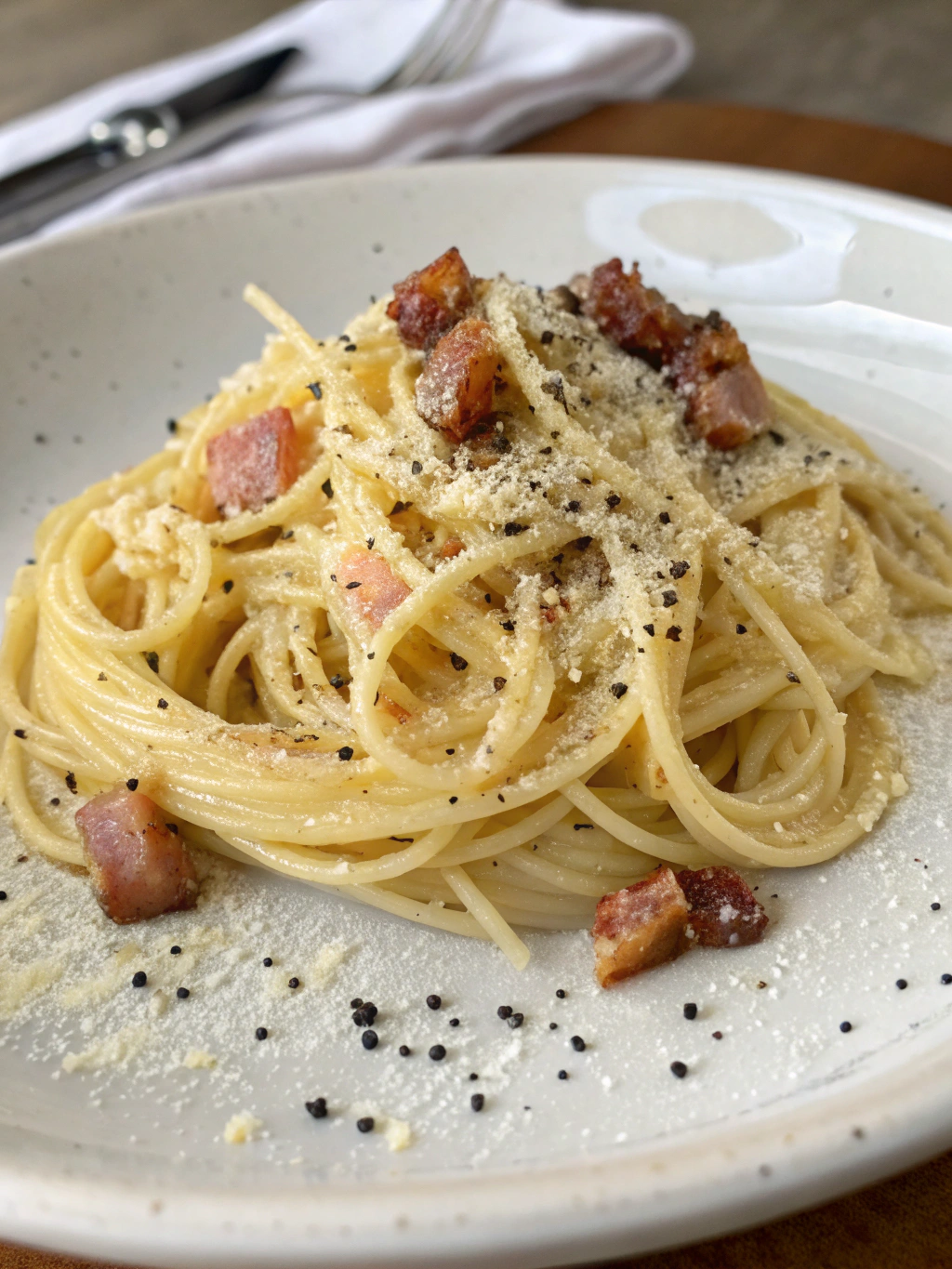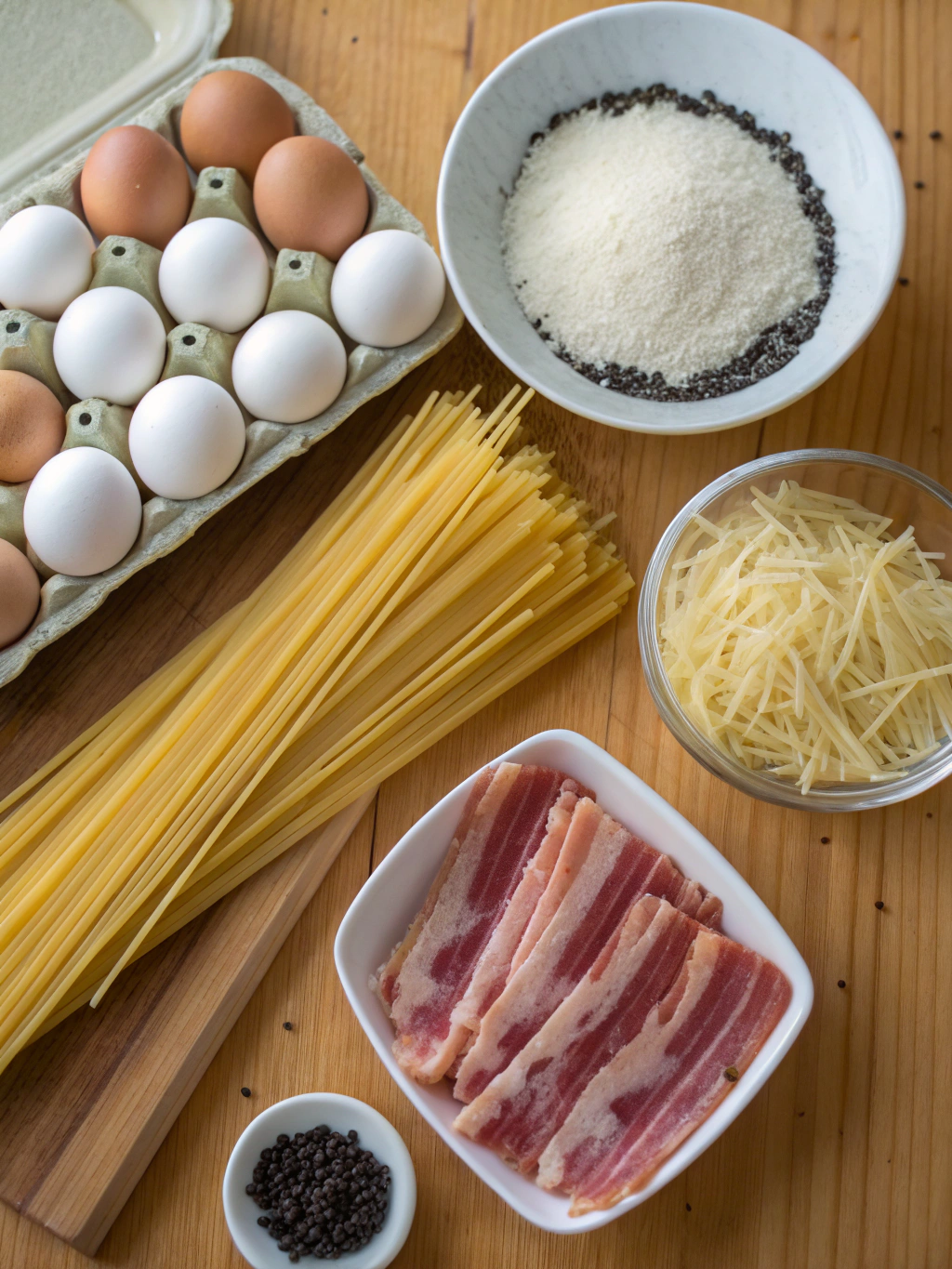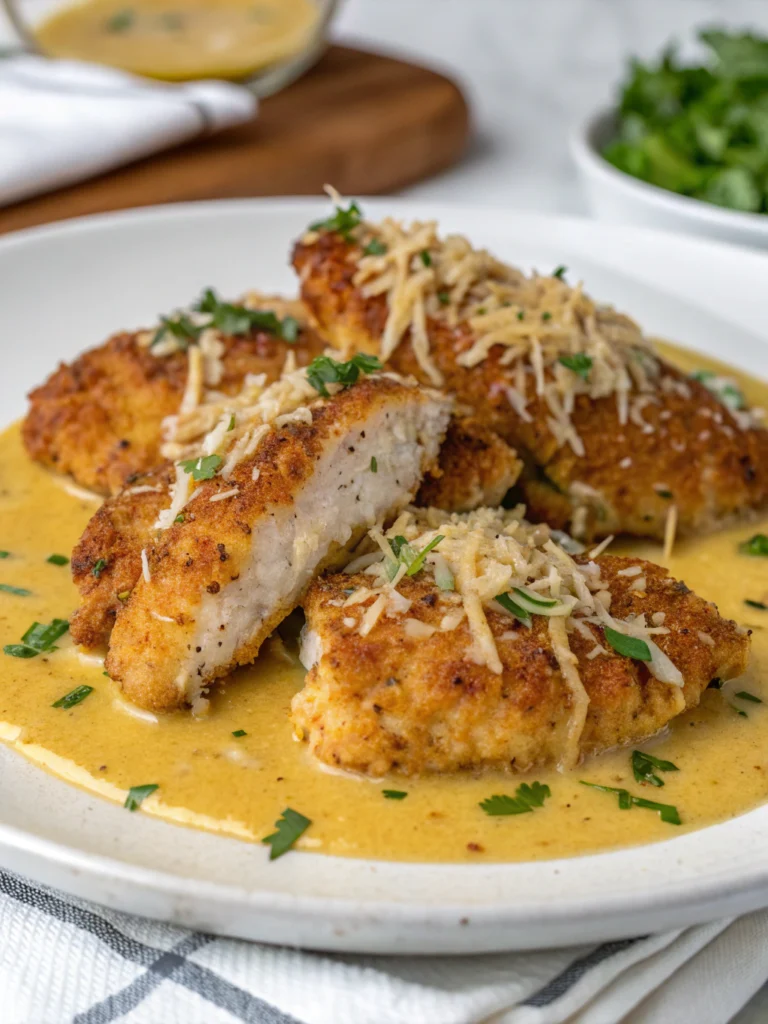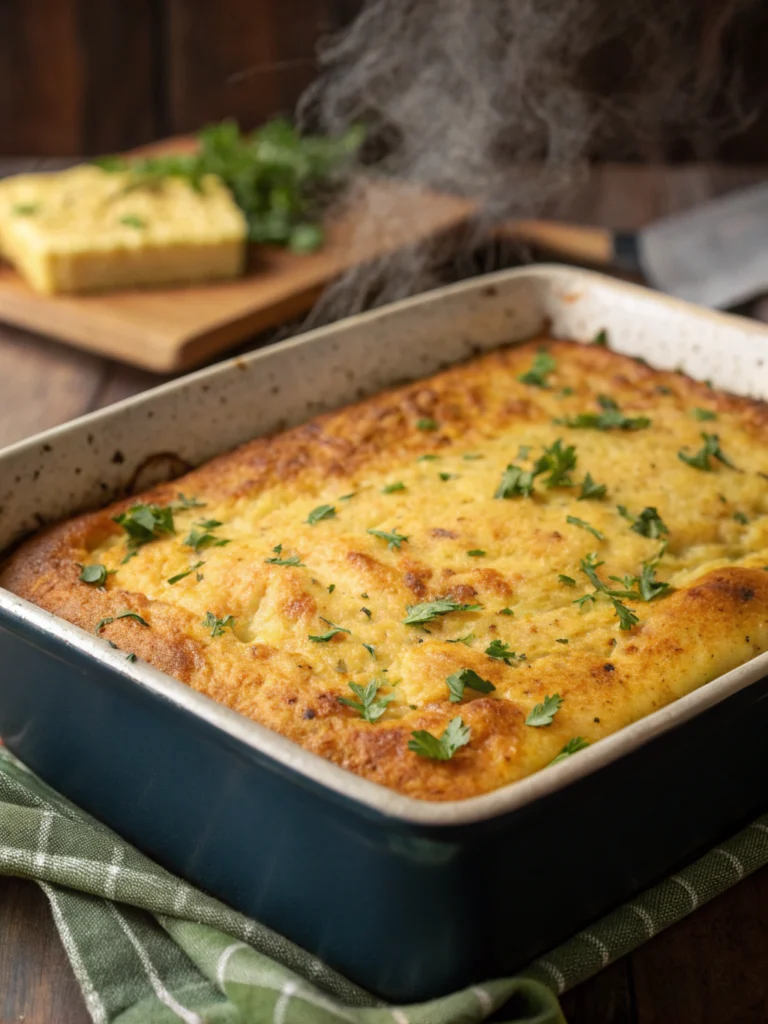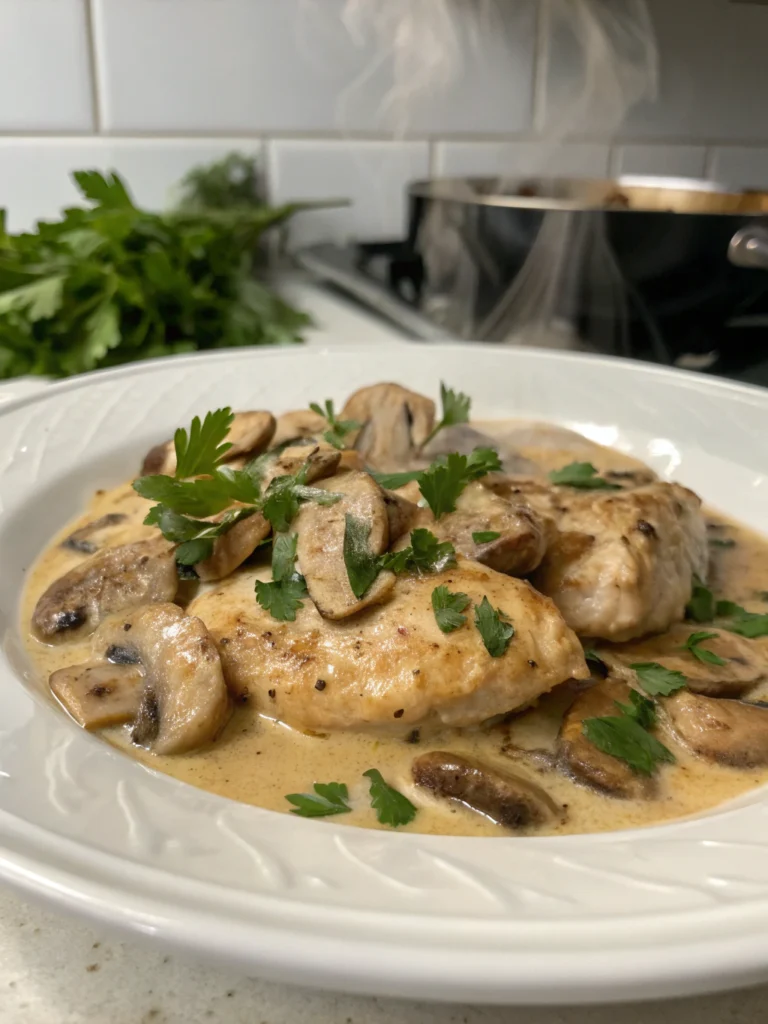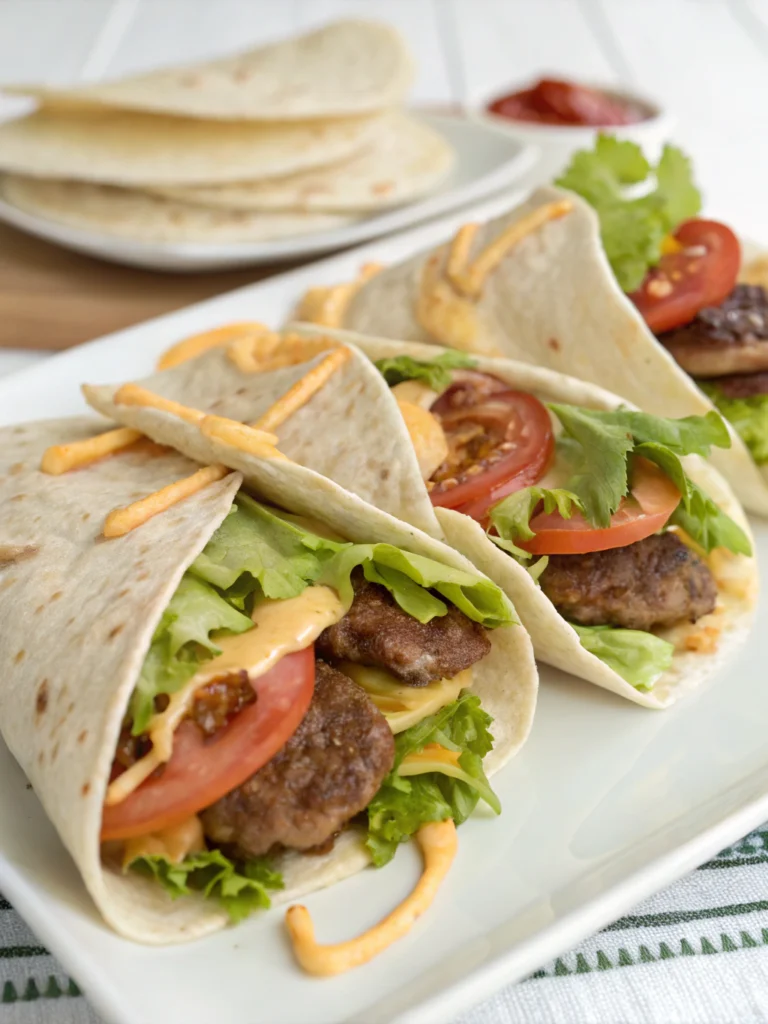Spaghetti Carbonara
A perfectly creamy, indulgent Italian pasta dish made with crispy pancetta, eggs, cheese, and black pepper. This authentic Spaghetti Carbonara recipe delivers restaurant-quality results in just 20 minutes using simple, high-quality ingredients.
Easy Spaghetti Carbonara Recipe
There’s something magical about Spaghetti Carbonara that transforms a handful of humble ingredients into one of the most beloved pasta dishes in the world. This classic Roman creation doesn’t rely on cream (despite what many recipes might claim) but instead achieves its silky, luxurious texture from the perfect emulsion of eggs, cheese, and pasta water. My homemade Spaghetti Carbonara recipe stays true to tradition while being incredibly approachable for home cooks of any skill level.
Carbonara has been a staple in Roman trattorias since the mid-20th century, though its exact origins remain debated. Some believe it was created to feed American soldiers after WWII using their rations of bacon and eggs, while others trace its roots to Italian charcoal workers (carbonari) who needed a hearty, energy-dense meal. Whatever its history, this dish remains a celebration of Italian simplicity and technique.
THIS RECIPE:
- Creates a silky, creamy sauce without using any actual cream
- Features the perfect balance of salty, savory pancetta and sharp Pecorino Romano
- Takes just 20 minutes from start to finish
- Requires only 6 main ingredients you likely already have
| Recipe Details | |
|---|---|
| Prep Time | 5 minutes |
| Cook Time | 15 minutes |
| Total Time | 20 minutes |
| Servings | 4 servings |
| Yield | 4 plates of pasta |
The beauty of Spaghetti Carbonara lies in its simplicity. With just a handful of quality ingredients and proper technique, you can create a restaurant-worthy pasta dish that will impress even the most discerning Italian food lovers. This recipe strikes the perfect balance between approachable and authentic, making it ideal for both weeknight family dinners and elegant entertaining.
Ingredients for Spaghetti Carbonara
The secret to exceptional Spaghetti Carbonara lies not in complicated techniques but in selecting the finest ingredients possible. Since this dish contains so few components, each one plays a crucial role in the final flavor profile. Whenever possible, opt for Italian-imported ingredients for the most authentic experience.
Main Ingredients:
- 1 pound (454g) dry spaghetti
- 8 ounces (227g) pancetta or guanciale, diced into ¼-inch cubes
- 4 large eggs, room temperature
- 1 cup (100g) freshly grated Pecorino Romano cheese
- ½ cup (50g) freshly grated Parmigiano Reggiano cheese
- 2 cloves garlic, minced (optional, for a slight variation)
- 2 teaspoons freshly cracked black pepper, plus more for serving
- ½ teaspoon kosher salt, plus more for pasta water
- 2 tablespoons fresh parsley, finely chopped (for garnish)
| Ingredient Category | Recommended Quality | Selection Tips |
|---|---|---|
| Pasta | Bronze-die extruded Italian pasta | Look for rough, porous texture that helps sauce cling |
| Pork | Guanciale (traditional) or pancetta (more accessible) | Avoid using regular American bacon which is too smoky |
| Cheese | Aged Pecorino Romano and Parmigiano Reggiano | Buy blocks and grate fresh; pre-grated contains anti-caking agents |
| Eggs | Fresh, organic, room temperature | Bring to room temp 30 minutes before cooking for proper sauce emulsion |
| Pepper | Freshly cracked black peppercorns | Grind just before using for maximum aroma and flavor |
Pro tip: The traditional Roman preparation uses only Pecorino Romano, but I find that adding some Parmigiano Reggiano creates a more balanced, less sharp flavor that appeals to a wider audience. For the most authentic version, use 1½ cups of Pecorino Romano and omit the Parmigiano.
How to Make Spaghetti Carbonara
Creating the perfect Spaghetti Carbonara is all about timing and temperature control. The goal is to create a silky, emulsified sauce without scrambling the eggs—a delicate balance that becomes second nature with practice. Let’s break down the process into manageable steps:
Prepare your ingredients:
- Bring eggs to room temperature at least 30 minutes before cooking
- Grate all cheese fresh and set aside
- Dice pancetta or guanciale into uniform pieces
- Have all ingredients measured and ready before beginning
Cook the pasta:
- Bring a large pot of water to a rolling boil
- Add 1 tablespoon kosher salt (less than usual as the pancetta and cheese add saltiness)
- Cook spaghetti 1 minute less than package directions for al dente
- Reserve 1½ cups pasta water before draining
Prepare the sauce base:
- In a large bowl, whisk together eggs, grated cheeses, black pepper, and ½ teaspoon salt
- Whisk in ¼ cup of the reserved hot pasta water to temper the eggs
Cook the pancetta:
- While pasta cooks, heat a large, cold skillet over medium heat
- Add diced pancetta and cook slowly until crisp and fat renders, about 8-10 minutes
- If using, add minced garlic for the last 30 seconds (just until fragrant)
- Remove skillet from heat
Create the carbonara:
- Working quickly, add hot, drained pasta to the skillet with pancetta
- Toss to coat pasta in rendered fat for 30 seconds
- Transfer pasta and pancetta mixture to the bowl with egg mixture (not the other way around)
- Toss continuously with tongs, adding splashes of hot pasta water as needed
- Continue tossing until a creamy sauce forms, about 1-2 minutes
Finish the dish:
- The residual heat from the pasta will cook the eggs to safe temperature while creating a silky sauce
- If sauce seems too thick, add more hot pasta water 1 tablespoon at a time
- Taste and adjust seasoning if necessary
- Serve immediately in warmed bowls
- Garnish with additional black pepper, grated cheese, and chopped parsley
Technical note: The most critical moment in making carbonara is combining the hot pasta with the egg mixture. The pasta should be hot enough to cook the eggs but not so hot that they scramble. Removing the pasta from heat and continuous tossing are key to achieving the perfect creamy consistency.
Tips for Making Spaghetti Carbonara
Mastering Spaghetti Carbonara is about understanding a few key principles that elevate this simple dish to extraordinary heights. Here are my expert recommendations based on years of perfecting this classic:
- Never add cream – Authentic carbonara gets its creaminess from eggs and cheese alone
- Temperature control is critical – Too hot and eggs scramble, too cool and sauce won’t form
- Work quickly but confidently – Have all ingredients prepped and ready before starting
- Use room temperature eggs – Cold eggs are more likely to seize up and scramble
| Technique | Recommendation | Why It Matters |
|---|---|---|
| Pasta Selection | Use bronze-die extruded pasta | Creates a rough surface that helps sauce adhere better |
| Pasta Water | Reserve more than you think you’ll need | Provides insurance for adjusting sauce consistency |
| Egg Mixture | Add cheese to eggs before pasta | Helps buffer eggs from heat to prevent scrambling |
| Tossing Method | Use tongs with constant motion | Ensures even coating and proper temperature distribution |
The most common mistake in making carbonara is allowing the eggs to scramble. To prevent this, make sure your skillet is off the heat before adding pasta to the egg mixture. The residual heat from the pasta and pancetta will gently cook the eggs to a safe temperature while maintaining that silky texture we’re after. If you’re nervous, try tempering the eggs with a bit more pasta water before adding the hot ingredients.
Pro tip: If your sauce starts to look grainy or scrambled, immediately add a splash of cold pasta water and stir vigorously. This can sometimes rescue a sauce that’s beginning to separate.
Make-Ahead Instructions
While Spaghetti Carbonara is best prepared and served immediately, there are ways to streamline the process for entertaining or busy weeknights:
You can prepare certain components in advance:
- Dice pancetta and store refrigerated for up to 2 days
- Grate cheeses and store in airtight containers for up to 3 days
- Measure and combine dry seasonings
- Bring eggs to room temperature 30 minutes before cooking
For the most efficient preparation, create a mise en place with all ingredients measured and ready. This turns the actual cooking into a quick 20-minute process that can be done right before serving.
If you absolutely must prepare partially in advance, you can:
- Cook the pancetta until crisp, then refrigerate
- When ready to serve, warm the pancetta in a skillet
- Cook fresh pasta and proceed with the recipe as written
Remember that carbonara is one of those dishes that truly shines when made fresh, so I recommend planning your meal timing around the final preparation rather than trying to fully make it ahead.
Storing Leftovers
Should you find yourself with leftover carbonara (though this is rare in my household!), proper storage is essential to maintain food safety and quality:
- Cool leftovers completely within 2 hours of cooking
- Store in airtight containers in the refrigerator
- Consume within 1-2 days for best quality
- Keep refrigerated at 40°F (4°C) or below
To reheat carbonara:
- Place in a skillet over low heat
- Add 1-2 tablespoons of water or broth
- Warm gently, stirring frequently
- Add a sprinkle of freshly grated cheese to refresh the dish
Be aware that reheated carbonara will never quite match the silky consistency of freshly made, as the eggs in the sauce will continue to cook during reheating. The texture becomes more like a traditional cream sauce but can still be delicious.
Freezing Spaghetti Carbonara
While I generally don’t recommend freezing Spaghetti Carbonara due to the egg-based sauce, there are circumstances where it might be necessary. Here’s how to do it with the best possible results:
- Allow carbonara to cool completely
- Portion into airtight, freezer-safe containers
- Leave slight headspace for expansion
- Label with date and contents
- Freeze for up to 1 month maximum
To thaw and reheat:
- Transfer from freezer to refrigerator and allow to thaw overnight
- Heat gently in a skillet over low-medium heat
- Add 2-3 tablespoons of milk or pasta water
- Stir frequently until heated through
- Add a touch of freshly grated cheese and black pepper to refresh flavors
Important note: The texture of frozen and reheated carbonara will be noticeably different from fresh, as the egg sauce tends to break when frozen. Consider this an emergency option rather than a recommended preservation method.
Serving Suggestions
Spaghetti Carbonara is a star on its own, but pairing it with complementary sides creates a complete Italian dining experience:
Recommended sides:
- Simple arugula salad with lemon vinaigrette and shaved Parmesan
- Roasted broccolini or asparagus with garlic and lemon zest
- Crusty Italian bread for sopping up any remaining sauce
- Marinated artichoke hearts or roasted cherry tomatoes for acidity
Presentation ideas:
- Serve in warmed shallow pasta bowls
- Twirl pasta into a neat mound using a large fork and ladle
- Garnish with additional freshly ground black pepper, a sprinkle of cheese, and fresh parsley
- Add a single crispy piece of pancetta on top as a visual cue to what’s inside
Wine pairings:
- A crisp, dry Italian white like Pinot Grigio or Frascati
- Light-bodied red such as Chianti Classico or young Montepulciano d’Abruzzo
- Sparkling Prosecco to cut through the richness
Carbonara should be served immediately while hot, as the sauce continues to thicken as it cools. The ideal serving temperature is steaming hot, with pasta that still has a slight bite to it (al dente).
FAQ
Can I use bacon instead of pancetta or guanciale?
While traditional Spaghetti Carbonara calls for guanciale or pancetta, you can substitute bacon in a pinch. Choose thick-cut bacon with minimal smoking and remove some of the rendered fat if it seems excessive. The flavor profile will be slightly different but still delicious.
Why did my carbonara sauce turn into scrambled eggs?
This happens when the eggs get too hot too quickly. To prevent scrambling, ensure your pasta isn’t excessively hot when combining with the egg mixture, remove the skillet from heat before adding pasta, and continuously toss the pasta to distribute heat evenly. Adding pasta water to the egg mixture before combining also helps temper the eggs.
Can I make Spaghetti Carbonara without raw eggs?
Traditional carbonara relies on eggs for its signature texture and flavor. The eggs are gently cooked by the heat of the pasta to a safe temperature. If you’re concerned about using raw eggs, look for pasteurized eggs, which are safe to consume even when not fully cooked. Alternative recipes using cream exist, but they’re not authentic carbonara.
What pasta shape works best for carbonara?
While spaghetti is traditional and gives the dish its name, other long pasta shapes like bucatini, linguine, or fettuccine work wonderfully. Avoid short pasta shapes like penne or farfalle, as they don’t allow the sauce to coat each strand as effectively.
Is cream ever used in authentic Spaghetti Carbonara?
No, authentic Roman carbonara never includes cream. The creamy texture comes solely from the emulsion of eggs, cheese, and starchy pasta water. Adding cream is a common adaptation outside Italy but changes the character of the dish significantly. For the most authentic experience, skip the cream and master the traditional technique.

